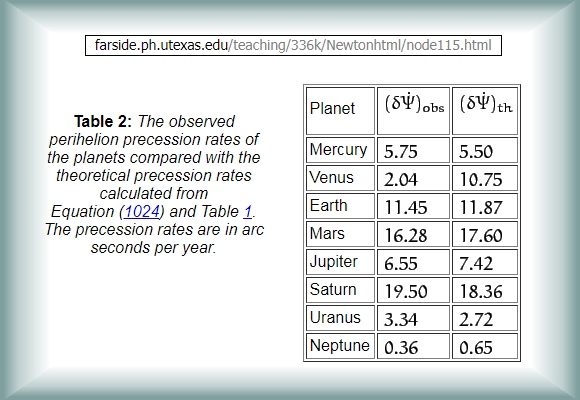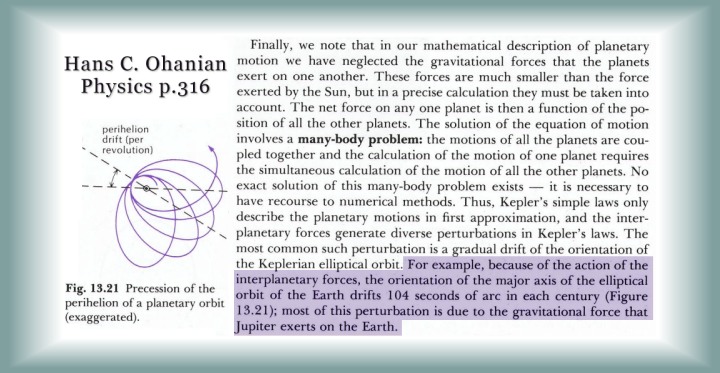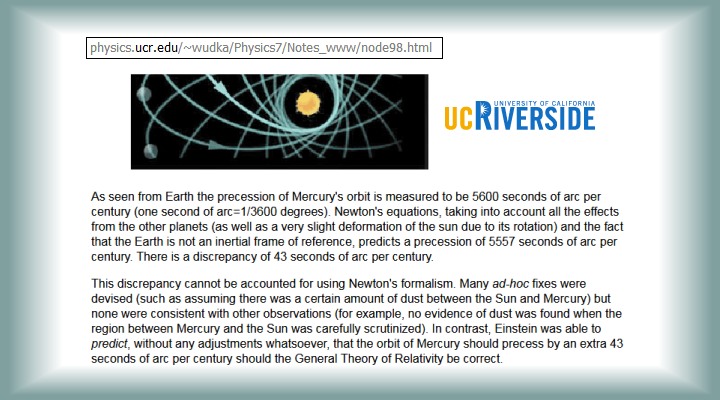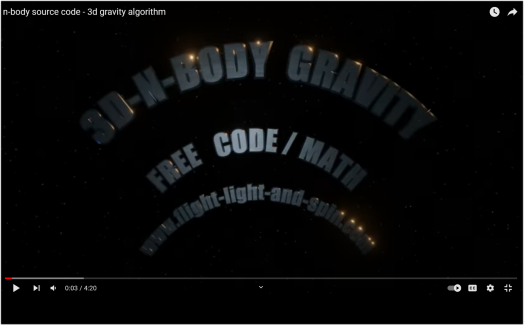So
which is it? Is observation of Perihelion Precession for Mercury
5600 or 575 or 550
arc-seconds per century? Is the discrepancy between observed
and theoretical 43 or 25?
And what accounts for those differences, precisely?
The only way to properly resolve these questions is to assume
a strict logical-positivist methodology. This being to take
no theoretical calculations for granted, and do all
the sums from scratch oneself - and then compare the results
to the various observational claims.
Well even my first approximation model in 2D
(orbit-gravity-sim-13.exe or OGS13) shows
that Mercury's Perihelion Precession is somewhere
in the region of 547
(+-12) arc-seconds per century due to Newton's
law. So it seems that the 5600 per century
is wrong. But is it? The details are quite intricate. Regardless
of which side we take, a sound methodology includes the careful
consideration as to how the other side managed to
get such a large error, or else its just a case of who cares
to belligerate the most vociferously.
All my answers offer a transparent and repeatable methodology
devoid of jargon and arcane symbols.
It is quite bemusing to read the phrase in the previous quote
from Riverside that it is a 'fact that the Earth
is not an inertial reference frame'! The moon certainly has
not been informed of this 'fact' as her orbit is
using the reference-frame of the Earth, and is also being
carried along by the Earth's gravity which is a side-effect
of the Earth having mass and thus inertia. The famous Michelson-Morley
experiment and the 'twins paradox' all classically explain
Einstein's Relativity by using the Earth as a reference frame!
So
why are Riverside claiming the Earth is not an inertial reference
frame?
The mis-representation from Riverside needs to be precisely
understood on its own terms.
To be fair, their point actually does have some abstract
merit, although their choice of wording shows that they have
not fully appreciated nor understood their own statement.
It has all the features of regurgitated-examination-based-theoretical-abbreviation.
Their confusing comment as to what qualifies as a valid inertial
reference frame arises because the Earth and Moon orbit their
common barycenter - and that barycenter is a more accurate
reference frame than the Earth alone. But the Earth-moon barycenter
can only be determined by considering each of their gravity
from the source of its own inertial reference frame; then
combining the two reference frames for a more accurate sum.
So it would be correct to say that 'the Earth is not a
complete reference frame'. It certainly is very
much a valid and essential frame of reference for
inertia and gravity in a genuine n-body solution.
When considering a satellite in orbit around the Earth, the
Earth-Moon barycenter is more accurate than the Earth's reference
frame alone, because the Moon will pull the satellite away
from the Earth by a small amount. But when you jump up in
the air, the Moon's tidal alteration to your jump is practically
worthless, and the only meaningful frame of reference is the
Earth.
But if we want to be obsessively accurate, then the only valid
reference frame is the gravitational barycenter of the entire
Universe. My algorithms always use the barycenter of the solar
system as its essential point of reference. But this can only
be calculated as a sum of all the reference frames
of the Sun and planets. So the Earth certainly is
an inertial reference frame. But its all just a matter of
accuracy as to how useful it is to use it on its own.
In the Newtonian paradigm, any reference frame is equally
valid so long as we take into account all the other significantly
massive bodies. In fact any theoretical physics should hold
to the principle that 'the laws of physics must be the
same in all (and any) reference frames'.
But as we saw in the previous
chapters, holding the formulae of Relativity to be the
same in all reference frames, gives numerical results
that differ between those reference frames!
Still, it all gets far murkier than this...







